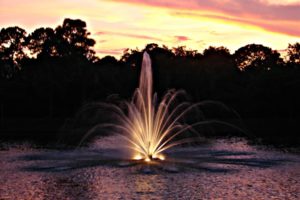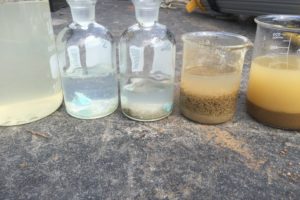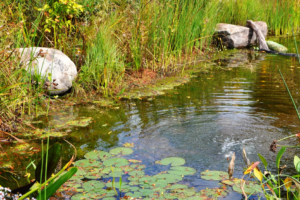Ponds play an essential role in the environment by helping to clean the air and purify water sources.
A vital aspect of pond management is testing the water for various qualities. The most common tests are KH, pH, GH, nitrates, and ammonia.

KH Levels in Ponds
KH, also known as carbonate hardness, serves as a buffer to keep pH levels stable and helps regulate the biological processes in the pond.
KH levels should be maintained between 5-10 ppm (parts per million) for optimal health.
Low KH Levels
Low KH may cause the water to become overly acidic, leading to the leaching of toxic metals like copper or iron that can be harmful if ingested.
To raise KH levels naturally, adding crushed coral or epoxy rocks into filtration units is recommended.
These materials dissolve slowly over time, releasing carbonates, increasing buffering capacity, and adding essential trace elements like calcium and magnesium that help promote healthy plant growth.
High KH Levels
To reduce KH levels, natural solutions such as adding plants like Anacharis or Water Lettuce can help balance out the chemistry of the ecosystem by taking in bicarbonates from the water during their photosynthetic process.
Regular partial water changes should be done to keep nitrate levels low and allow oxygen replenishment within the water column.
pH Levels in Ponds
The pH level of a pond is an essential measure of its water quality, and it should be tested regularly to ensure the health of its inhabitants.
The ideal range for pH in a pond is between 6.5 – 9.0.
Low pH Levels
To correct an issue with low pH levels, add products like baking soda or limestone. This treatment increases alkalinity in small increments until the desired range is reached.
High pH Levels
To lower high pH levels, add peat moss to absorb excess nutrients in the water.
Additionally, adding acidic elements such as vinegar, lemon juice, or ammonia can help bring down overall acidity in a controlled manner.
GH Levels
GH stands for General Hardness, which measures the amount of calcium and magnesium in the water.
A good range for GH levels in ponds is between 5-15 ppm.
Low GH Levels
To address an issue with low GH levels, add products like limestone or calcium carbonate in small increments until the desired range is reached.
High GH Levels
To lower GH levels in a pond, consider adjusting the water’s pH balance using chemicals like sodium bicarbonate or potassium hydroxide.
Using mechanical filters such as air stones helps maintain balanced pH levels by increasing surface area for gas exchange between the water column and surrounding air.
Introducing plants like Anubias or Java ferns can also help reduce GH levels. These plants absorb excess minerals through their roots and utilize them during photosynthesis.
Nitrates
Nitrites are a product of the nitrogen cycle, which is responsible for maintaining balance in aquatic ecosystems.
The ideal range for nitrite levels in a pond is 0 – 0.3 ppm.
Low Nitrate Levels
Low nitrate levels can hinder the growth of plants due to a lack of available Nitrogen for photosynthesis. At the same time, some aquatic species may suffer from reduced oxygenation due to inadequate nitrate concentrations within the water.
Introducing phosphate-free organic fertilizers such as alfalfa meal or liquid fish emulsion is one way to replenish nitrates organically and safely.
These fertilizers contain ammonia, which is broken down by bacteria into ammonium (NH4+) and subsequently converted into nitrate (NO3–) that plants can use for healthy growth.
High Nitrate Levels
High nitrate concentrations can lead to an overabundance of nutrients in the water column, resulting in harmful algae blooms that may deplete oxygen levels and cause fish kills or other disturbances to aquatic life.
Elevated Nitrogen levels in the system can stunt plant growth and negatively impact water quality by causing murky conditions due to organic waste buildup.
Adding phosphate-free organic fertilizers such as alfalfa meal or liquid fish emulsion can help replenish Nitrogen without introducing potentially harmful compounds found in chemical fertilizers.
Ammonia
Ammonia is a product of organic matter breaking down, such as fish waste or uneaten food.
The ideal range for ammonia levels in a pond is 0 – 0.5 ppm, the lower the better. Ammonia is toxic to fish and other aquatic life, and must be quickly converted to Nitrites and then Nitrates by a healthy ecosystem filled with a wide range of well-established bacteria, otherwise your fish and other aquatic life may start dying. Low ammonia levels indicate a healthy ecosystem that is quickly converting Ammonia into the less harmful Nitrites and Nitrates.
High Ammonia Levels
Having high ammonia levels can also be damaging to a pond’s ecosystem since it increases toxicity within the environment.
To lower ammonia levels, reduce sources of Nitrogen such as fish food by cutting back on feeding schedules. Or, you can perform additional partial water changes with clean, fresh water every few days if you have a small pond. You can also introduce beneficial bacteria cultures like Nitrospira to help accelerate the conversion of ammonia into nitrites.
The Importance of Maintaining a Healthy Pond Ecosystem
At PondMedics, we work with customers to keep their ponds healthy. Contact us to learn about our customized, proactive plans to help you meet your goals.





